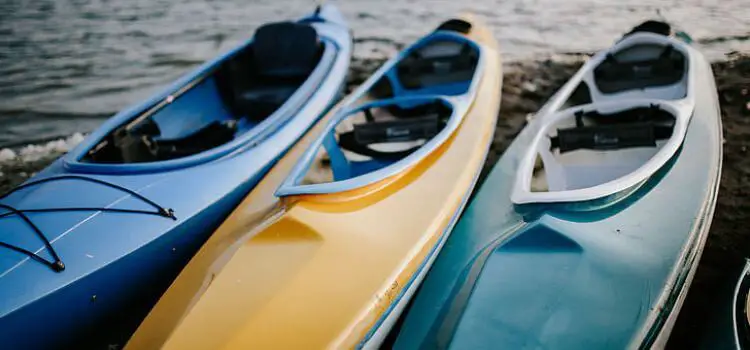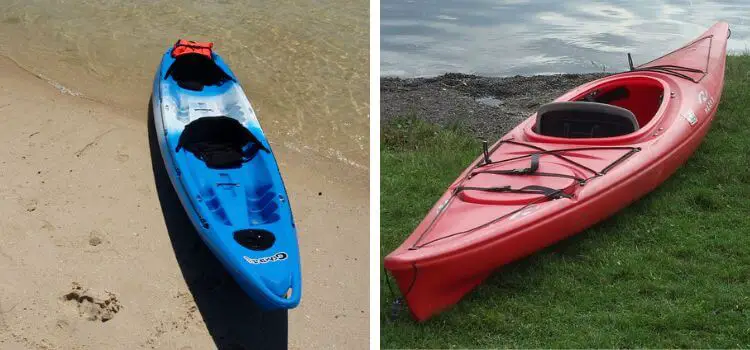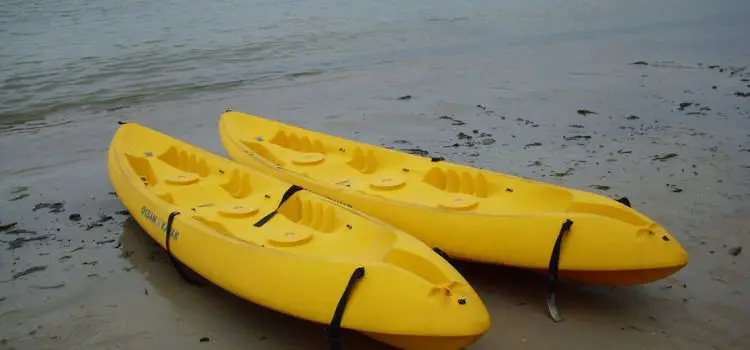As an Amazon Associates, I earn from quality purchases.
Are you considering purchasing a kayak for your next water adventure? Comparison between an open vs closed kayak can be a crucial segment that impacts your overall experience on the water.
In this guide, we will explore the differences between open kayaks and closed kayaks. We will help you make an informed choice that suits your needs. Whether you’re a beginner seeking stability or an experienced paddler looking for speed and maneuverability, understanding the characteristics of open and closed kayaks is essential.
So, let’s dive into the open vs closed kayak comparison and find the perfect vessel for your aquatic escapades.
Open vs Closed Kayak: Key features
Features | Open Kayak | Closed Kayak |
Design | Open, sit-on-top | Enclosed cockpit |
Entry/Exit | Easy | Can be challenging |
Stability | High | Lower initial stability |
Speed | Slower | Faster and more efficient |
Maneuverability | Average | Higher maneuverability |
Protection | Limited | Provides more protection from elements |
Self-draining | Yes | No, may require bailing |
Skill Level | Beginner-friendly | Suitable for various skill levels |
Water Accumulation | Minimal | Potential for water accumulation |
Transportation | Bulkier, may require roof racks | Easier to transport, fits inside vehicles |
Popular Uses | Recreational, fishing | Touring, whitewater |
Open Kayaks

A. Definition and Characteristics:
Open kayaks, also known as Sit-on-top kayaks, are a type of kayak characterized by their open, cockpit-free design. Instead of sitting inside the kayak, paddlers sit on top of a molded seat or deck. These kayaks are typically wider. They are more stable than closed or sit-in kayaks, providing a user-friendly platform for various water activities.
B. Advantages:
1. Easy Entry and Exit:
One of the significant advantages of open kayaks is their easy entry and exit. Without an enclosed cockpit, paddlers can simply climb onto or off the kayak from the water. They are ideal for swimming, snorkeling, or any activity that involves frequent on-and-off access.
2. Self-Draining Design:
Open kayaks feature a self-draining design. They have scupper holes or scuppers strategically placed throughout the hull. These openings allow water to drain out of the kayak automatically, ensuring a drier and more comfortable experience.
3. Enhanced Stability:
Thanks to their wider hulls and broader decks, open kayaks offer enhanced stability. This stability provides a more secure and balanced platform for paddlers. They are popular among beginners, families, and individuals seeking a relaxing recreational experience.
4. Ideal for Recreational Use and Beginners:
Open kayaks are well-suited for recreational use and beginners. Their stable nature and user-friendly design make them easy to paddle and maneuver, instilling confidence in new kayakers. They are also versatile for various water activities like fishing, leisurely paddling, and exploring calm waters.
C. Limitations:
1. Exposure to the Elements:
Since open kayaks lack an enclosed cockpit, paddlers are more exposed to the elements. Splashes from waves, wind, and sun exposure are more prominent. They require appropriate clothing, sun protection, and potentially waterproof gear.
2. Slower Speed Compared to Sit-In Kayaks:
Due to their wider hulls and increased water resistance, open kayaks tend to be slower than closed kayaks. This may not be a concern for casual recreational paddling. But, those seeking greater speed or covering long distances may find open kayaks less efficient.
3. Less Protection from Waves and Wind:
Compared to closed kayaks with enclosed cockpits, open kayaks provide less protection from waves and wind. Paddlers may experience more water splashing onto the deck, which can be a factor to consider when paddling in rough or windy conditions.
Whether you’re a beginner looking for stability and easy access or simply prefer the open design for recreational activities, open kayaks offer a fun and versatile option on the water.
Closed Kayaks

A. Definition and Characteristics:
Closed kayaks, also known as Sit-in kayaks, are a type of kayak known for their enclosed cockpit design. Paddlers sit inside the kayak’s hull, with their legs and lower body positioned inside the cockpit. These kayaks typically have a narrower profile. They offer a range of features suitable for different water conditions and paddling styles.
B. Advantages:
1. Protection from the Elements:
Closed kayaks provide greater protection from the elements compared to open kayaks. The enclosed cockpit shields the paddler from water splashes, wind, and sun exposure. They offer a more comfortable and weather-resistant paddling experience.
2. Increased Speed and Efficiency:
Due to their streamlined design and narrower hulls, closed kayaks offer increased speed and efficiency in the water. Paddlers can glide through the water with less resistance. They are a preferred choice for those who prioritize performance and covering longer distances.
3. Suitable for Various Water Conditions:
Closed kayaks are versatile and suitable for various water conditions. They handle well in calm waters. But their design also allows for paddling in rougher conditions, such as coastal areas or open water. The enclosed cockpit provides added protection from waves and wind.
4. Enhanced Maneuverability:
Closed kayaks are known for their enhanced maneuverability. The lower center of gravity and closer contact between the paddler and the kayak allows for greater control and agility. This makes closed kayaks popular for activities that require precise maneuvering, such as navigating narrow waterways or tackling whitewater rapids.
C. Limitations:
1. Less Initial Stability:
Closed kayaks generally have lower initial stability compared to open kayaks. The narrower hull design may feel less stable for beginners or those who prefer a more stable platform. However, they compensate for this with increased secondary stability, which improves as the kayak leans during turns.
2. Difficulty with Entry and Exit:
Getting in and out of a closed kayak can be more challenging compared to an open kayak. Paddlers need to fit into the cockpit opening. It may require some flexibility and practice, especially in situations where quick entry or exit is necessary.
3. Potential for Water Accumulation:
Unlike self-draining open kayaks, closed kayaks do not have a self-draining design. In the event of capsizing or water splashing into the cockpit, water may accumulate inside the kayak. This requires manual removal or the use of bilge pumps to keep the cockpit dry.
Whether you prioritize protection from the elements, speed, efficiency, or maneuverability in various water conditions, closed kayaks offer a versatile and dynamic option for your kayaking adventures.
Key Factors to Consider
A. Intended Use and Environment:
When choosing between an open kayak and a closed kayak, consider your intended use and the environment in which you’ll be kayaking. Open kayaks are well-suited for recreational activities, fishing, and casual paddling in calm waters.
Closed kayaks excel in touring, longer expeditions, and handling various water conditions, including coastal areas and whitewater rapids. Assess your specific goals and the type of water you’ll be exploring to determine which kayak aligns best with your intended use.
B. Skill Level and Experience:
Your skill level and experience in kayaking should also influence your decision. Open kayaks are generally beginner-friendly due to their stability and easy entry/exit. They provide a great starting point for novice paddlers to build confidence and skills.
Closed kayaks can cater to a range of skill levels, who may have more experience with maneuvering, rolling, and handling different water conditions.
C. Comfort and Personal Preferences:
Consider your comfort and personal preferences when choosing between open and closed kayaks. Open kayaks offer an open, unrestricted seating arrangement and allow for easy movement and flexibility. They are popular among those who enjoy swimming, snorkeling, or simply having the freedom to move around.
Closed kayaks provide a more enclosed and snug cockpit. You may find them comfortable, especially during long trips or in colder weather. Consider which seating style and overall kayak design align with your comfort and paddling preferences.
D. Transportation and Storage:
Another practical factor to consider is transportation and storage. Open kayaks tend to be bulkier and may require roof racks or specialized transportation methods. They are less compact for storage purposes.
Closed kayaks, on the other hand, are generally easier to transport as they can fit inside vehicles. Their more streamlined shape and compact size make them convenient for those with limited storage space or who prefer hassle-free transportation.
By evaluating these key factors, you can make a well-informed decision when choosing between open and closed kayaks. Consider your intended use, skill level, comfort preferences, and practical needs to find the kayak that perfectly matches your paddling style and enhances your overall kayaking experience.
Open vs Closed Kayak Comparisons

1. Design:
- Open Kayak features an open, sit-on-top design where the paddler sits on a molded seat or atop a deck.
- Closed Kayak offers an enclosed cockpit design with the paddler sitting inside the kayak’s hull.
2. Entry/Exit:
- Open Kayak provides easy entry and exit due to the open design. The paddler can easily climb on or off the kayak from the water.
- Closed Kayaks can be more challenging to enter and exit since the paddler needs to fit into the cockpit opening.
3. Stability:
- Open Kayak offers high initial stability due to the wider hull and broader deck. This stability makes them popular for beginners and recreational use.
- Closed Kayak generally has lower initial stability due to the narrower hull design. However, they provide secondary stability, which increases as the kayak leans.
4. Performance
- Open kayaks tend to have better tracking abilities. They offer good initial stability, particularly in calm waters.
- Closed kayaks, on the other hand, generally offer increased speed and efficiency. They are ideal for those who are seeking higher performance. They also provide enhanced maneuverability, allowing for agile navigation in tight spaces.
5. Storage
- Open kayaks may have limited storage options. But, they often have open storage wells or bungee cords on the deck. They provide convenient access to essentials like water bottles or fishing gear.
- Closed kayaks have an advantage as they typically have a larger storage capacity due to their enclosed cockpit design. This allows for more gear and equipment to be securely stored inside the kayak.
6. Speed:
- Open Kayak tends to be slower compared to closed kayaks due to their wider hull and increased water resistance.
- Closed kayak offers better speed and efficiency due to its streamlined design and lower water resistance.
7. Maneuverability:
- Open Kayak offers average maneuverability. It is suitable for casual paddling and recreational activities.
- Closed Kayak provides higher maneuverability. They are ideal for activities like touring and navigating through narrow waterways.
8. Protection:
- Open Kayak provides limited protection from the elements, as the paddler is exposed to water splashes, wind, and sun.
- Closed Kayak offers more protection from the elements due to the enclosed cockpit, shielding the paddler from water, wind, and sun exposure.
9. Self-Draining:
- Open Kayak features a self-draining design with scupper holes or scuppers. They allow water to drain out automatically.
- Closed Kayak does not have a self-draining design and may require manual bailing if water accumulates in the cockpit.
10. Skill Level:
- Open Kayaks are beginner-friendly due to their stability and easy entry/exit. They are popular for recreational paddling and fishing.
- Closed Kayaks are suitable for various skill levels, including intermediate and advanced paddlers, depending on the specific model and intended use.
11. Water Accumulation:
- Open Kayak generally experiences minimal water accumulation, as water drains through the scupper holes.
- Closed Kayaks can potentially accumulate water in the cockpit, especially if capsized or during rough water conditions. They require manual removal.
12. Transportation:
- Open Kayaks are bulkier and may require roof racks or specialized transportation methods. They are less compact for transportation.
- Closed Kayaks are easier to transport. They are more compact and can fit inside vehicles, requiring less external equipment.
13. Popular Uses:
- Open Kayaks are well-suited for recreational paddling, fishing, and activities where easy entry/exit and stability are essential.
- Closed Kayaks are commonly used for touring, longer expeditions, whitewater kayaking, and activities that require higher maneuverability.
Remember, these comparisons provide a general overview. Specific models within each type of kayak may have variations in features and performance. It’s essential to consider personal preferences, intended use, and skill level when choosing between open kayaks and closed kayaks.
Which Kayak is Beginner friendly?
Open kayaks are often recommended as the preferred choice for beginners due to several key factors. One of the main advantages of open kayaks is their enhanced stability. The wider hull design and broader deck provide a more stable platform on the water.
They are easier for beginners to maintain balance and feel secure. This stability instills confidence. It allows beginners to focus on developing their paddling technique without the constant worry of tipping over.
Easy Entry and Exit:
In addition to stability, the open cockpit design of open kayaks offers easy entry and exit. There are no enclosed spaces or cockpit rims to navigate, making it simple for beginners to get in and out of the kayak. This accessibility is particularly valuable for those who are new to kayaking and may not yet have developed the flexibility or familiarity with traditional closed kayak entry techniques.
The ease of entry and exit enhances the overall experience. It reduces any potential frustration or anxiety associated with launching and landing the kayak.
Self-Draining System:
Another advantage of open kayaks is their self-draining design. These kayaks are equipped with scupper holes or scuppers placed throughout the hull. These openings allow water that enters the kayak to drain away automatically. They keep the paddler drier and more comfortable.
This feature is especially beneficial for beginners who may encounter splashes, waves, or small amounts of water entering the kayak. The self-draining design eliminates the need for manual bailing, further simplifying the kayaking experience for beginners.
Open kayaks also offer versatility, making them suitable for various water activities. They are popular choices for recreational use, fishing, and leisurely paddling. The open design allows for easy movement and provides a sense of freedom while on the water.
Beginners can explore different environments without feeling confined or restricted. This versatility allows beginners to experiment with different activities and discover their specific interests within the realm of kayaking.
Overall, open kayaks are beginner-friendly due to their stability, easy entry and exit, self-draining design, and versatility. These features combine to create a positive and enjoyable paddling experience for beginners, enabling them to develop their skills and confidence as they embark on their kayaking journey.
Which One Should You Buy?

Based on your specific needs and preferences, I would suggest considering an open kayak. Here are some reasons why:
Beginner-Friendly:
Open kayaks are generally regarded as more beginner-friendly due to their stability and easy entry/exit. The wider hull and open cockpit design provide a stable platform. The simplicity of getting on and off the kayak enhances the overall paddling experience for newcomers.
Versatility:
Open kayaks are versatile and cater to a wide range of recreational activities. Whether you’re interested in leisurely paddling, fishing, or even snorkeling, an open kayak can accommodate various water activities. This versatility allows you to explore different environments and try out different experiences without feeling limited.
Safety and Self-Draining Design:
Open kayaks are considered safer for beginners. In the event of a capsize, the open design and self-draining features make it easier for paddlers to reenter the kayak or swim to shore. The absence of an enclosed cockpit eliminates the risk of being trapped. It provides peace of mind for beginners who may still be developing their paddling skills.
Low Maintenance:
Open kayaks typically require less maintenance compared to closed kayaks. The self-draining design allows water to easily drain away, preventing the accumulation of water in the cockpit. Additionally, open kayaks are often made of durable materials that can withstand rough handling. They are less prone to damage and require fewer repairs.
Accessible for All Ages:
Open kayaks are suitable for individuals of all ages and body types. Their open design and ease of use make them accessible for children, older adults, and individuals with limited mobility. It’s a kayak style that can be enjoyed by the whole family, promoting inclusivity and shared experiences on the water.
Considering these factors, an open kayak would be a great choice for a beginner like you. Its stability, versatility, safety features, low maintenance requirements, and accessibility make it an ideal option to embark on your kayaking adventures with confidence and enjoyment.
Conclusion
When comparing open vs closed kayaks, both options have their distinct advantages and considerations. The choice between the two ultimately depends on your specific needs, skill level, and intended use. Open kayaks, with their beginner-friendly design, stability, and versatility, are well-suited for recreational activities, fishing, and casual paddling.
On the other hand, closed kayaks offer increased protection from the elements, enhanced speed, and efficiency. They are suitable for various water conditions. By carefully assessing your preferences, comfort requirements, and the type of experience you seek, you can make an informed decision between open and closed kayaks.
Whether you opt for the openness of an open kayak or the enclosed cockpit of a closed kyak, both choices provide unique opportunities to explore and immerse yourself in the wonders of kayaking.
Frequently Asked Questions (FAQs):
Q: Are open kayaks more stable than closed kayaks?
A: Open kayaks are generally considered more stable due to their wider hulls and open design. They are a popular choice for beginners and recreational use.
Q: Can I use a closed kayak in rough water conditions?
A: Closed kayaks can handle rough water conditions. But it’s important to have the necessary skills and experience to navigate such conditions safely. Their enclosed cockpit design provides some protection from waves and splashes.
Q: Are open kayaks faster than closed kayaks?
A: Closed kayaks tend to be faster and more efficient due to their streamlined design and lower profile, which allows for smoother and faster paddling.
Q: Can I store my belongings in an open kayak?
A: Yes, open kayaks often have storage options such as open storage wells, bungee cords, or compartments, where you can securely store your belongings while kayaking.
Q: Do closed kayaks offer better protection from the elements?
A: Yes, closed kayaks provide better protection from the elements. The enclosed cockpit shields you from wind, waves, and sun exposure, keeping you more protected and dry.
Q: Are closed kayaks more maneuverable than open kayaks?
A: Closed kayaks are generally more maneuverable due to their lower center of gravity and direct contact between the paddler’s body and the kayak. They allow for better control and agility.
Q: Can I use an open kayak for fishing?
A: Yes, open kayaks are popular for fishing due to their stability, open deck space, and convenient access to gear. Many open kayaks also have fishing-specific features such as rod holders and additional storage options.

Leave a Reply